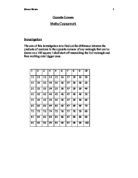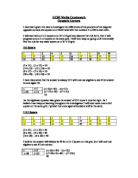Prove formula works
Investigate rectangles(with same method).
Change grid size.
Squares:
I started by calculating the differences for 2x2-4x4 boxes and then predicting the difference for a 5x5.
2x2- 1x12=12 2x13=26 3x14=42 4x15=60 5x16=80
2x11=22 3x12=36 4x13=52 5x14=70 6x15=90
(diff.)10 10 10 10 10
3x3- 1x23=23 2x24=48 3x25=75
3x21=63 4x22=88 5x23=115
(diff.)40 40 40
4x4- 1x34=34 2x35=70 3x36=108
4x31=124 5x32=160 6x33=198
(diff.)90 90 90
To make a prediction for a 5x5 I saw that the existing differences were firstly multiples of 10. Then if you divide them by 10 they are square numbers(1,4,9). The next logical number in the sequence would be 160 as it is a multiple of 10 and a square number when divided by 10.
To test my prediction I calculated two box locations on the 10x10 grid.
5x5- 1x45=45 2x46=92
5x41=205 6x42=252
(diff.)160 160
To prove using algebra why the difference is always the same for squares I used this diagram to represent the grid.
n n+1
n+10 n+11
n(n+11)= n²+11n
(n+10)(n+1)=n²+10n+n
n²+11n+10
n²+11n
10
To find a formula for any square on a 10x10 grid I created this table from the parts above:
Looking at the last column I noticed that the numbers were 1 less than the dimension size in the 1st column.
Working backwards I took 1 dimension(d) then subtracted 1, squared it then multiplied by 10 to give this formula:
(d-1)²x10
I then proved my formula worked by testing it with a 3x3 box.
(3-1)²x10
2²x10
4x10=40
Rectangles:
As for squares I firstly calculated the differences for 4 different sized rectangles.
2x3- 1x13=13 2x14=28
3x11=33 4x12=48
- 20
2x4- 1x14=14 2x15=30
4x11=44 5x12=60
- 30
3x4- 1x24=24 2x25=50
4x21-84 5x22=110
- 60
3x5- 1x25=25 2x26=52
5x21-105 6x22=132
80 80
The first pattern I noticed was that all the differences were multiples of 10.
To prove that the difference is always the same for a rectangle I used algebra in the same way as for squares.
n n+1 n+2
n+10 n+11 n+12
n(n+12)=n²+12n
(n+10)(n+2)=n²+12n+20
n²+12n
n²+12n+20
20
I created this table for rectangles:
I worked out from the table and other evidence the formula:
(w-1)(l-1)x10
w=width l=length
Grid Size:
I started to try and find a formula for any grid size for a square and rectangle.
I saw that in both formulae there was a x10 at the end. I thought that this may be the grid size.
I tested my prediction with a 3x3 box and a 2x3 rectangle on a 20x20 grid.
3x3- (3-1)²x20 2x3- (2-1)(3-1)x20
2²X20 1x2x20
4x20=80 2x20=40
Actual Differences:
3x3- 1x43=43 2x3- 1x42=42
3x41=123 2x41=82
80 40








